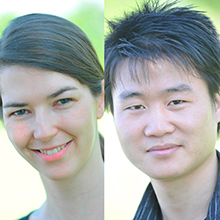Immunoproteasome Inhibits Healing Function of Macrophages

The macrophages recognize and eliminate foreign materials and pathogens and alert the immune system to invaders by sending out numerous inflammatory signals. When the inflammation has run its course, the macrophages also help cleaning up and thus play a specific role in wound healing. For this clean-up function of macrophages, which is referred to as alternative activation, interleukin 4 (IL-4) is of key importance.
Immunoproteasome regulates alternative macrophage activation
The team led by PD Dr. Silke Meiners and Dr. Tobias Stöger of the Institute of Lung Biology and Disease (iLBD) / Comprehensive Pneumology Center (CPC) at Helmholtz Zentrum München has now found that the immunoproteasome regulates the IL-4 stimulation of the macrophages. It inhibits the IL-4 signaling pathway and thus reduces alternative macrophage activation.
“In experiments with alveolar macrophages, we showed that in cells lacking the immunoproteasome, a specific receptor for IL-4 is augmented,” said Ilona Kammerl, who shares the first authorship of the publication with Shanze Chen. The immunoproteasome inhibits the IL-4 signaling pathway and thus limits its effect.
Effect can be influenced by specific anti-immunoproteasome drugs
To confirm these results, the research team used a pharmacological immunoproteasome inhibitor. The aim was to block the IL-4 signaling pathway and thus allow the macrophages to increasingly switch to the repair and clean-up mode. “As hypothesized, when we added the inhibitor we observed a significantly stronger alternative activation of the alveolar macrophages,” said study leader Tobias Stöger.
The scientists now want to determine in animal models whether targeted treatment with specific inhibitors of the immunoproteasome accelerates the healing processes in the lung, for example, after acute pneumonia. Corresponding preliminary experiments are already underway.
Further information
The immunoproteasome* is a cylindrical protein complex which is particularly present in immune cells and which helps break down proteins into smaller components. Its function is similar to a cellular shredder.
Original publication:
Chen, S. et al. (2016). Immunoproteasome dysfunction augments alternative polarization of alveolar macrophages, Cell Death Differentiation
DOI: 10.1038/cdd.2016.3
Link zur Fachpublikation http://www.nature.com/cdd/journal/vaop/ncurrent/full/cdd20163a.html
As German Research Center for Environmental Health, Helmholtz Zentrum München pursues the goal of developing personalized medical approaches for the prevention and therapy of major common diseases such as diabetes mellitus and lung diseases. To achieve this, it investigates the interaction of genetics, environmental factors and lifestyle.
The Helmholtz Zentrum München has about 2,300 staff members and is headquartered in Neuherberg in the north of Munich. Helmholtz Zentrum München is a member of the Helmholtz Association, a community of 18 scientific-technical and medical-biological research centers with a total of about 37,000 staff members. www.helmholtz-muenchen.de/en/index.html
The Institute of Lung Biology and Disease (ILBD) is part of the Comprehensive Pneumology Center (CPC) which is a joint research project of the Helmholtz Zentrum München, the Ludwig-Maximilians-Universität with its University Hospital and the Asklepios Fachkliniken München-Gauting. The CPC's objective is to conduct research on chronic lung diseases in order to develop new diagnosis and therapy strategies.
The CPC maintains a focus on experimental pneumology with the investigation of cellular, molecular and immunological mechanisms involved in lung diseases. The CPC is one of five sites of the German Center for Lung Research (Deutsches Zentrum für Lungenforschung, DZL). www.helmholtz-muenchen.de/en/ilbd/index.html
The German Center for Lung Research (DZL) pools German expertise in the field of pulmonology research and clinical pulmonology. The association’s head office is in Giessen. The aim of the DZL is to find answers to open questions in research into lung diseases by adopting an innovative, integrated approach and thus to make a sizeable contribution to improving the prevention, diagnosis and individualized treatment of lung disease and to ensure optimum patient care. www.dzl.de/index.php/en
Contact for the media:
Department of Communication, Helmholtz Zentrum München – German Research Center for Environmental Health (GmbH), Ingolstädter Landstr. 1, 85764 Neuherberg – Phone: +49 89 3187 2238 – Fax: +49 89 3187 3324 – E-mail: presse@helmholtz-muenchen.de
Scientific contact at Helmholtz Zentrum München:
Dr. Tobias Stöger, Helmholtz Zentrum München – Deutsches Forschungszentrum für Gesundheit und Umwelt (GmbH), Comprehensive Pneumology Center Ingolstädter Landstraße 1, 85764 Neuherberg- Tel. +49 89 3187 3104 – E-mail: tobias.stoeger@helmholtz-muenchen.de
https://www.helmholtz-muenchen.de/en/news/latest-news/press-information-news/art…
Media Contact
All latest news from the category: Life Sciences and Chemistry
Articles and reports from the Life Sciences and chemistry area deal with applied and basic research into modern biology, chemistry and human medicine.
Valuable information can be found on a range of life sciences fields including bacteriology, biochemistry, bionics, bioinformatics, biophysics, biotechnology, genetics, geobotany, human biology, marine biology, microbiology, molecular biology, cellular biology, zoology, bioinorganic chemistry, microchemistry and environmental chemistry.
Newest articles

A ‘language’ for ML models to predict nanopore properties
A large number of 2D materials like graphene can have nanopores – small holes formed by missing atoms through which foreign substances can pass. The properties of these nanopores dictate many…

Clinically validated, wearable ultrasound patch
… for continuous blood pressure monitoring. A team of researchers at the University of California San Diego has developed a new and improved wearable ultrasound patch for continuous and noninvasive…

A new puzzle piece for string theory research
Dr. Ksenia Fedosova from the Cluster of Excellence Mathematics Münster, along with an international research team, has proven a conjecture in string theory that physicists had proposed regarding certain equations….



